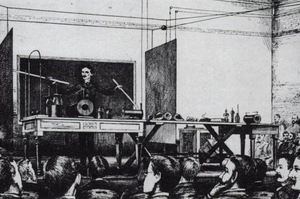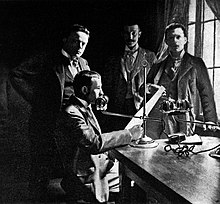19th century
The meaning and usage of the word "radio" has developed in parallel with developments within the field of communications and can be seen to have three distinct phases: electromagnetic waves and experimentation; wireless communication and technical development; and radio broadcasting and commercialization. Many individuals—inventors, engineers, developers, businessmen - contributed to produce the modern idea of radio and thus the origins and 'invention' are multiple and controversial. Early radio designs could not transmit sound or speech and were called the "wireless telegraph".Development from a laboratory demonstration to a commercial entity spanned several decades and required the efforts of many practitioners. In 1878, David E. Hughes noticed that sparks could be heard in a telephone receiver when experimenting with his carbon microphone. He developed this carbon-based detector further and eventually could detect signals over a few hundred yards. He demonstrated his discovery to the Royal Society in 1880, but was told it was merely induction, and therefore abandoned further research.
Experiments were undertaken by Thomas Edison and his employees of Menlo Park. Edison applied in 1885 to the U.S. Patent Office for a patent on an electrostatic coupling system between elevated terminals. The patent was granted as U.S. Patent 465,971 on December 29, 1891. The Marconi Company would later purchase rights to the Edison patent to protect them legally from lawsuits.
In 1893, in St. Louis, Missouri, Nikola Tesla made devices for his experiments with electricity. Addressing the Franklin Institute in Philadelphia and the National Electric Light Association, he described and demonstrated the principles of his wireless work. The descriptions contained all the elements that were later incorporated into radio systems before the development of the vacuum tube. He initially experimented with magnetic receivers, unlike the coherers (detecting devices consisting of tubes filled with iron filings which had been invented by Temistocle Calzecchi-Onesti at Fermo in Italy in 1884) used by Guglielmo Marconi and other early experimenters.
A demonstration of wireless telegraphy took place in the lecture theater of the Oxford University Museum of Natural History on August 14, 1894, carried out by Professor Oliver Lodge and Alexander Muirhead. During the demonstration a radio signal was sent from the neighboring Clarendon laboratory building, and received by apparatus in the lecture theater.
In 1895 Alexander Stepanovich Popov built his first radio receiver, which contained a coherer. Further refined as a lightning detector, it was presented to the Russian Physical and Chemical Society on May 7, 1895. A depiction of Popov's lightning detector was printed in the Journal of the Russian Physical and Chemical Society the same year. Popov's receiver was created on the improved basis of Lodge's receiver, and originally intended for reproduction of its experiments.
In 1895, Marconi built a wireless system capable of transmitting signals at long distances (1.5 mi./ 2.4 km). In radio transmission technology, early public experimenters had made short distance broadcasts. Marconi achieved long range signalling due to a wireless transmitting apparatus and a radio receiver claimed by him. From Marconi's experiments, the phenomenon that transmission range is proportional to the square of antenna height is known as "Marconi's law". This formula represents a physical law that radio devices use. Marconi's experimental apparatus proved to be a complete, commercially successful radio transmission system. According to the Proceedings of the United States Naval Institute in 1899, the Marconi instruments had a "[...] coherer, principle of which was discovered some twenty years ago, [and was] the only electrical instrument or device contained in the apparatus that is at all new".
In 1896, Marconi was awarded British patent 12039, Improvements in transmitting electrical impulses and signals and in apparatus there-for, for radio. In 1897, he established a radio station on the Isle of Wight, England. Marconi opened his "wireless" factory in Hall Street, Chelmsford, England in 1898, employing around 50 people. Shortly after the 1900s, Marconi held the patent rights for radio.
20th century
In 1900, Brazilian priest Roberto Landall de Moura accomplish the transmission of the human voice by a wireless machine, that is, by irradiating an electromagnetic wave, modulated by an audio signal. According the newspaper Jornal do Comercio (June 10, 1900), he conducted his first public experiment on June 3, 1900, in front of journalists and the General Consul of Great Britain, Mr. C.P. Lupton, in the City of São Paulo, Brazil, reaching a distance of approximately 8 km. The points of transmission and reception were the Alto de Santana and Paulista Avenue in the downtown sector . One year after the above experiment in public, he received his first patent from the Brazilian government. It was described as "equipment for the purpose of phonetic transmissions through space, land and water elements at a distance with or without the use of wires". Four months later, conscious that his invention had real value, he left Brazil for the United States of America with the intent of patenting the machine at the U S Patent Office in Washington, DC. With scarce resources he had to rely on friends to push ahead his project. In spite of great difficulties, three patents were finally awarded: "The Wave Transmitter" (October 11, 1904) which is the precursor of today's radio transceiver; "The Wireless Telephone" and the "Wireless Telegraph", both those dated November 22, 1904. The next advancement was the vacuum tube detector, invented by Westinghouse engineers. On Christmas Eve, 1906, Reginald Fessenden used a synchronous rotary-spark transmitter for the first radio program broadcast, from Ocean Bluff-Brant Rock, Massachusetts. Ships at sea heard a broadcast that included Fessenden playing O Holy Night on the violin and reading a passage from the Bible. This was, for all intents and purposes, the first transmission of what is now known as amplitude modulation or AM radio. The first radio news program was broadcast August 31, 1920 by station 8MK in Detroit, Michigan, which survives today as all-news format station WWJ under ownership of the CBS network. The first college radio station began broadcasting on October 14, 1920, from Union College, Schenectady, New York under the personal call letters of Wendell King, an African-American student at the school. That month 2ADD, later renamed WRUC in 1947, aired what is believed to be the first public entertainment broadcast in the United States, a series of Thursday night concerts initially heard within a 100-mile (160 km) radius and later for a 1,000-mile (1,600 km) radius. In November 1920, it aired the first broadcast of a sporting event. At 9 pm on August 27, 1920, Sociedad Radio Argentina aired a live performance of Richard Wagner's Parsifal opera from the Coliseo Theater in downtown Buenos Aires. Only about twenty homes in the city had receivers to tune in this radio program. Meanwhile, regular entertainment broadcasts commenced in 1922 from the Marconi Research Centre at Writtle, England.
The next advancement was the vacuum tube detector, invented by Westinghouse engineers. On Christmas Eve, 1906, Reginald Fessenden used a synchronous rotary-spark transmitter for the first radio program broadcast, from Ocean Bluff-Brant Rock, Massachusetts. Ships at sea heard a broadcast that included Fessenden playing O Holy Night on the violin and reading a passage from the Bible. This was, for all intents and purposes, the first transmission of what is now known as amplitude modulation or AM radio. The first radio news program was broadcast August 31, 1920 by station 8MK in Detroit, Michigan, which survives today as all-news format station WWJ under ownership of the CBS network. The first college radio station began broadcasting on October 14, 1920, from Union College, Schenectady, New York under the personal call letters of Wendell King, an African-American student at the school. That month 2ADD, later renamed WRUC in 1947, aired what is believed to be the first public entertainment broadcast in the United States, a series of Thursday night concerts initially heard within a 100-mile (160 km) radius and later for a 1,000-mile (1,600 km) radius. In November 1920, it aired the first broadcast of a sporting event. At 9 pm on August 27, 1920, Sociedad Radio Argentina aired a live performance of Richard Wagner's Parsifal opera from the Coliseo Theater in downtown Buenos Aires. Only about twenty homes in the city had receivers to tune in this radio program. Meanwhile, regular entertainment broadcasts commenced in 1922 from the Marconi Research Centre at Writtle, England.Sports broadcasting began at this time as well, including the first broadcast college football game.

